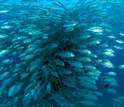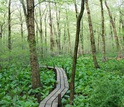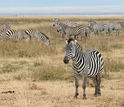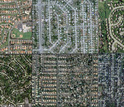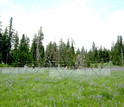News Release 15-077
Infectious disease ecology, forest biodiversity, urban ecology featured at upcoming conference
National Science Foundation-funded research findings presented at 2015 Ecological Society of America conference in August
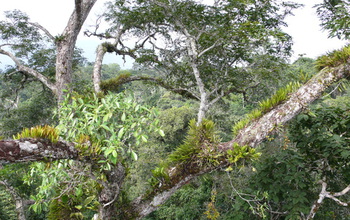
NSF-funded scientists will report research results on forest biodiversity at the ESA conference.
July 15, 2015
This material is available primarily for archival purposes. Telephone numbers or other contact information may be out of date; please see current contact information at media contacts.
The ecology of cities across the U.S., spread of infectious diseases such as Ebola, worldwide forests under siege, and how life thrives in Earth's critical zone are among the topics featured at the 2015 meeting of the Ecological Society of America (ESA), held Aug. 9-14, 2015 in Baltimore, Md.
Other subjects to be addressed include the role of long-term ecological research, Earth's coupled natural and human systems, and primary productivity--the base of the food web--across ecosystems.
"This year's ESA conference promises to be a key event for ecologists of all stripes," says Alan Tessier, acting director of the National Science Foundation's (NSF) Division of Environmental Biology, which primarily funds the research listed below, along with NSF's Divisions of Ocean Sciences, Earth Sciences, and Atmospheric and Geospace Sciences. "Numerous sessions will highlight important outcomes of NSF funding programs," says Tessier.
Participants in the conference--Ecological Science at the Frontier: Celebrating ESA's Centennial--will look back at the history of the field of ecology, and forward into its future.
The meeting features an extensive slate of talks and poster presentations by NSF-supported researchers. A selection of these sessions follows.
Monday, Aug. 10, 2015
An Ecology in, of, and for the City
1:30 p.m.-5:00 p.m., Baltimore Convention Center, Room 308
Boston and Baltimore. Miami and Minneapolis. Phoenix and Los Angeles. In locations from coast to prairie to desert, what do these cities have in common? Urban ecology can provide answers. In the past decade, the discipline of urban ecology has come into its own, scientists say. Earlier urban ecological research focused on the green components "in" cities. Now a more comprehensive approach that investigates entire urban complexes as ecological systems--an ecology "of" cities--has been added. Ecological information can be used to improve the environmental quality of urban environments and the quality of life for urban residents--an ecology "for" cities. Presentations will demonstrate how urban ecology has helped the overall discipline of ecology increase its relevance to the solution of environmental problems--and the quality of life on a human-dominated planet. Research results are funded by NSF's Long-Term Ecological Research (LTER) program.
8:00 p.m.-10:00 p.m., Baltimore Convention Center, Room 309
This event will foster broader connections and identify emerging opportunities in continental and global-scale research networks. Speakers/poster presenters and participants from ESA, the American Geophysical Union (AGU), and national and international research networks will identify opportunities and prospects for collaborations, growth and support at ESA and AGU meetings. The event will foster communication and outreach with representatives from NSF's Critical Zone Observatory (CZO) Network, National Ecological Observatory Network (NEON), and LTER Network. This event is co-sponsored by ESA and AGU, and will be linked to a follow-on event at the AGU Fall 2015 meeting.
Tuesday, Aug. 11, 2015
The Macroecology of Infectious Disease
1:30 p.m.-5:00 p.m., Baltimore Convention Center, Room 344
Ebola, MERS (Middle East Respiratory Syndrome), malaria, antibiotic-resistant infections: Is our interaction with the environment somehow responsible for their increased incidence? A critical issue facing modern science is identifying the global-scale patterns and drivers of infectious diseases, and their effects on humans and on ecosystems. Despite decades of research on pathogen ecology and emergence, many questions have only recently been addressed at large scales, such as what drives global patterns of pathogen diversity, are there predictors of cross-species transmission and zoonotic disease emergence, and how might disturbances such as habitat loss and climate change affect regional variation in disease outcomes? This session will demonstrate the ways in which the perspectives and tools of macroecology are transforming an understanding of infectious disease ecology. Integrating macroecology and infectious disease ecology has the potential, scientists say, to provide new approaches for mapping pathogen diversity and risk, and, ultimately, development of a framework for predicting global patterns of infectious disease emergence in the face of rapid environmental change. The research is funded by the NSF-NIH-USDA Ecology and Evolution of Infectious Diseases (EEID) program.
Functional, Phylogenetic and Genetic Dimensions of Forest Diversity and Change
1:30 p.m.-5:00 p.m., Baltimore Convention Center, Room 317
Whither the diversity of life on Earth, especially in the world's forests? Around the globe, forests are under siege. They face multiple pressures due to shifts in temperature and precipitation, as well as deforestation and degradation as a result of land use change. Predicting how forest communities will be affected by future shifts in climate and land-use change is a major challenge. The talks in this session are a step toward an understanding of tree species abundance, distribution, and demography across landscapes. For example, in areas that experience more frequent or severe droughts, shifts in species composition and diversity in communities depend on variation in drought tolerance. Session talks incorporate multiple dimensions of biodiversity that are key to predicting the resilience of forest communities to global change. Presenters are funded by NSF's Dimensions of Biodiversity program.
1:30 p.m.-5:00 p.m., Baltimore Convention Center, Room 328
The region between the top of the forest canopy and the base of weathered rock: our living environment and Earth's critical zone. The critical zone sustains life through its provision of services such as climate regulation and water purification. Ecological processes are integral to critical zone processes, yet little integration of the field of ecology has taken place in critical zone science, researchers say. The goal of this symposium is to bridge the gap between critical zone science and ecology, and to attract more ecologists to critical zone science. Participants in this session are supported through NSF's CZO program.
Wednesday, Aug. 12, 2015
Coupled Natural and Human Systems Science: The Need, Challenges and Rewards
1:30 p.m.-5:00 p.m., Baltimore Convention Center, Room 309
Humans and the environment are one interconnected system, scientists have found. Ecologists need to embrace coupled natural and human systems in their science if they are to provide much-needed guidance on how we can sustain and improve the livelihoods of rapidly growing human populations--without compromising the integrity of the ecosystems on which we depend. This symposium will synthesize the current state-of-the-art in coupled systems research, and highlight new advances. It will demonstrate the relevance of a coupled systems approach to environmental policy and management through case studies drawn from diverse ecosystems, including montane forests, tropical islands and coasts, and countries including Brazil, China, French Polynesia, Mexico and the U.S. The talks are on projects funded by NSF's Dynamics of Coupled Natural and Human Systems (CNH) program.
Thursday, Aug. 13, 2015
Federal Agency Networking Session
11:30 a.m.-1:15 p.m., Baltimore Convention Center, Room 316
How does a scientist obtain support for his or her work from NSF or other federal funding agencies? Navigating these agencies for research and funding opportunities can be complex, especially for early career investigators. Representatives from multiple federal agencies and organizations involved in ecological research will share information about funding, opportunities, and/or fellowships at their institutions. This session, chaired by NSF, will feature program officers from NSF, DOD, DOE, EPA, NASA, NOAA, USDA, U.S. Forest Service, USGS, and the Smithsonian Institution. After each agency's presentation, representatives will meet with session participants in small groups to answer questions.
The Role of Long-Term Studies in Advancing Ecological Understanding
1:30 p.m.-5:00 p.m., Baltimore Convention Center, Room 314
Acid rain. It was a problem that largely affected U.S. eastern states. Or so scientists thought. Has acid rain now blown over? Or is there a new dark cloud on the horizon? Long-term studies on such subjects as acid rain have provided critical insights into our understanding of the structure and function of ecological systems. These studies have often reversed conclusions based on short-term research, uncovered previously unknown ecological interactions, and allowed for an understanding of longer-term ecological and evolutionary processes. They've revealed the effects of human modifications of the environment, led to improved management plans, and are critical for predicting and managing future environmental changes, scientists believe. This session will highlight the contributions of long-term research to ecological science, management, and policy. It will also feature the ways in which the most pressing environmental issues, now and in the future, rely on scientific infrastructure that supports research on long-term ecological trends, such as field stations, historical collections, long-term monitoring, and databases. Presenters are funded by NSF's LTER program.
Understanding the Dynamics and Controls of Primary Productivity in a Changing World
3:30 p.m.-5:00 p.m., Baltimore Convention Center, Room 345
Nature's alchemy, it might be called. At the base of Earth's food webs, organisms convert sunlight, water and carbon dioxide into chemical energy. Primary productivity, as the process is known, is everywhere: in growing forests, lawns that need mowing, and spreading algae blooms. Understanding the dynamics of primary productivity is a long-standing theme in ecology, but few studies are conducted over long enough time scales to enable global analyses. This session will highlight insights into the patterns of change and the regulation of primary production from long-term studies that span more than a decade. The goal is to reveal common changes across ecosystems, including lakes, rivers, wetlands, grasslands, deserts and forests. The session will also highlight ways in which education activities and relationships with policy-makers have improved literacy about ecological systems, and have informed decisions about primary productivity in landscapes. Talks are supported by NSF's LTER program.
-NSF-
-
Fisheries and policy--coupled natural and human systems--is a conference session subject.
Credit and Larger Version -
Walk the path to federal funding at an ESA session with program officers from NSF, other agencies.
Credit and Larger Version -
The ecology and evolution of infectious diseases in ungulates, other species, is an ESA highlight.
Credit and Larger Version -
Urban ecology is a focus at ESA. Here, San Diego, Miami, Philadelphia, Chicago, Phoenix, Levittown.
Credit and Larger Version -
ESA topic: the Nutrient Network. Shown here: fences near the NSF H.J. Andrews LTER site in Oregon.
Credit and Larger Version
Media Contacts
Cheryl Dybas, NSF, (703) 292-7734, email: cdybas@nsf.gov
Related Websites
NSF Discovery Article Series: Long-Term Ecological Research: http://nsf.gov/discoveries/disc_summ.jsp?cntn_id=135004
NSF Discovery Article Series: Ecology and Evolution of Infectious Diseases: http://nsf.gov/discoveries/disc_summ.jsp?cntn_id=134947
NSF Discovery Article Series: Critical Zone Observatories: http://nsf.gov/discoveries/disc_summ.jsp?cntn_id=130991
NSF Discovery Article Series: Long-Term Research in Environmental Biology: http://www.nsf.gov/discoveries/disc_summ.jsp?cntn_id=131114
NSF Discovery Article Series: Environmental Research and Education: http://nsf.gov/discoveries/disc_summ.jsp?cntn_id=134889
NSF Special Report: Ecology and Evolution of Infectious Diseases: http://www.nsf.gov/news/special_reports/ecoinf/
ESA 2015: NSF Long-Term Ecological Research site presentations: http://bit.ly/1JMExno
ESA Session on Ecology in the Critical Zone: http://www.esa.org/esa/ecology-from-treetop-to-bedrock-human-influence-in-earths-critical-zone/
The U.S. National Science Foundation propels the nation forward by advancing fundamental research in all fields of science and engineering. NSF supports research and people by providing facilities, instruments and funding to support their ingenuity and sustain the U.S. as a global leader in research and innovation. With a fiscal year 2023 budget of $9.5 billion, NSF funds reach all 50 states through grants to nearly 2,000 colleges, universities and institutions. Each year, NSF receives more than 40,000 competitive proposals and makes about 11,000 new awards. Those awards include support for cooperative research with industry, Arctic and Antarctic research and operations, and U.S. participation in international scientific efforts.
Connect with us online
NSF website: nsf.gov
NSF News: nsf.gov/news
For News Media: nsf.gov/news/newsroom
Statistics: nsf.gov/statistics/
Awards database: nsf.gov/awardsearch/
Follow us on social
Twitter: twitter.com/NSF
Facebook: facebook.com/US.NSF
Instagram: instagram.com/nsfgov

